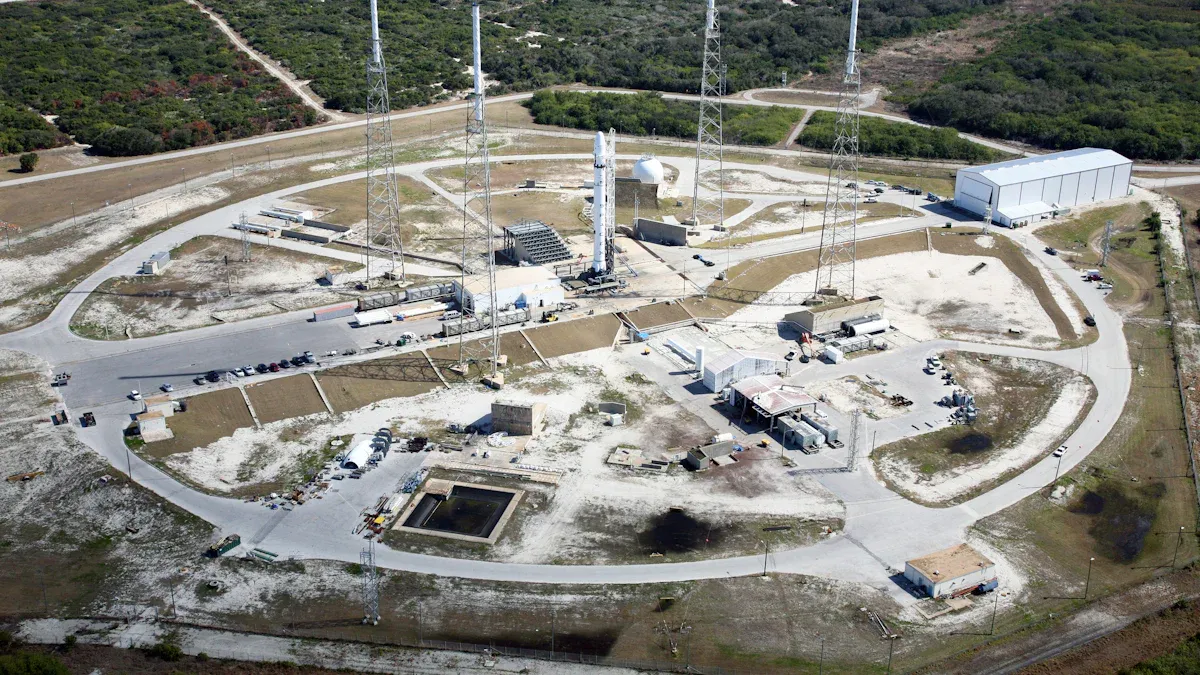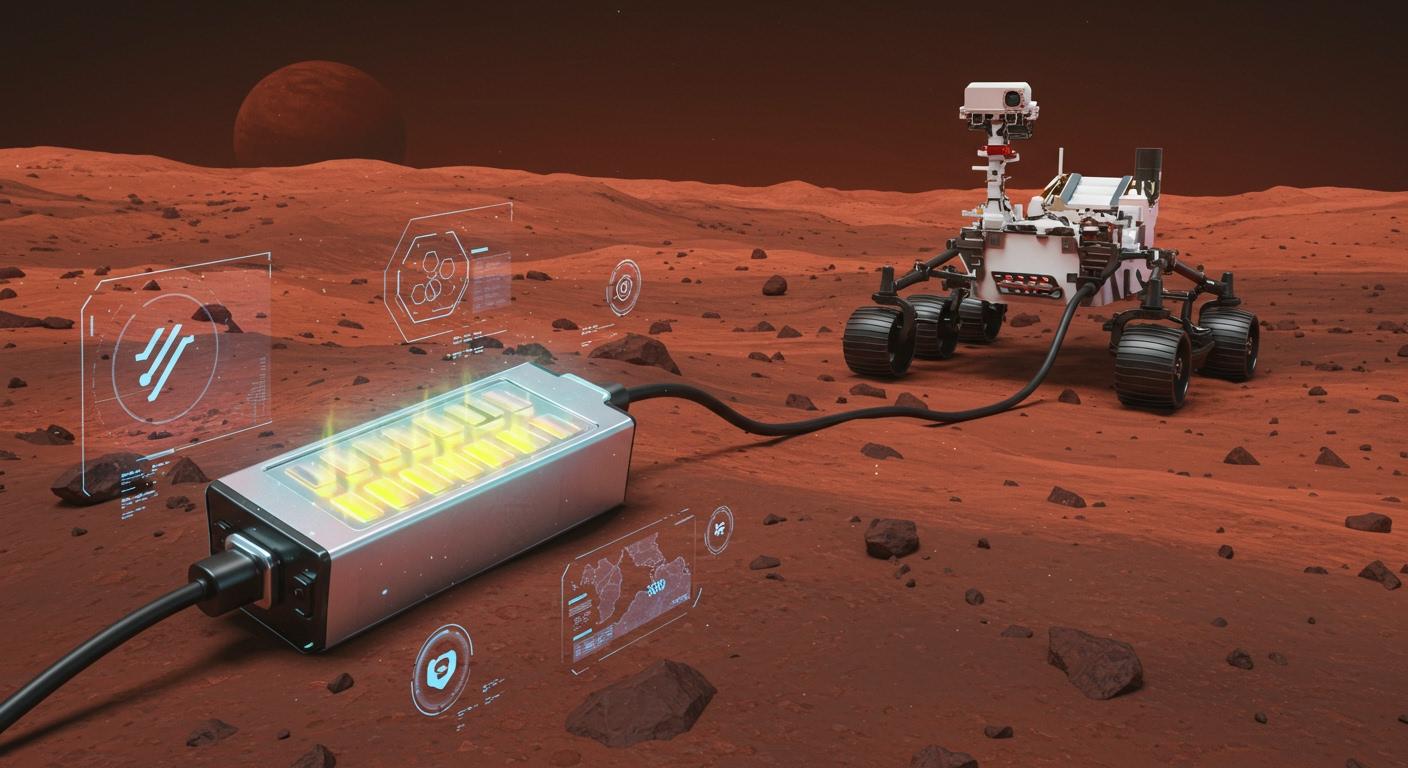Lighter, Faster-Charging Batteries for Mars Exploratio
You now witness a major shift in mars exploration, thanks to lighter and faster-charging batteries. Efficient power sources keep your spacesuit and scientific equipment running in the harsh Martian environment. Recent breakthroughs in battery technology allow engineers to use the Martian atmosphere and advanced materials for energy.
- Advancements in battery technology have led to significant weight reductions in Mars exploration equipment.
- The Mars battery reduces the need for heavy energy storage components to be launched from Earth.
- This innovation allows for increased payload capacity for scientific instruments and other critical equipment.
Faster-Charging Batteries are opening new possibilities, making Mars missions more practical and safe for you.
Key Takeaways
- Lighter batteries enhance Mars exploration by reducing equipment weight, allowing for more scientific tools and supplies.
- Faster-charging batteries improve mission efficiency, enabling astronauts to spend more time exploring and less time waiting for power.
- Advanced materials like silicon anodes and Buckypaper increase battery capacity and durability, making them ideal for harsh Martian conditions.
- CO₂-powered batteries utilize the Martian atmosphere for energy, reducing reliance on Earth-based supplies and enhancing mission sustainability.
- Ongoing research in battery technology promises to improve energy storage solutions for both Mars missions and renewable energy systems on Earth.
Mars Battery Challenges

Martian Environment
You face unique challenges when you try to power equipment on Mars. The Martian environment is harsh and unpredictable. Temperatures swing from warm during the day to extremely cold at night. These changes can damage batteries and reduce their efficiency. For example, storing lithium-ion batteries at sub-freezing temperatures can crack the battery’s cathode. This damage lowers the battery’s capacity and shortens its lifespan. If you charge and discharge a battery in the cold, you might lose up to 5% more capacity after 100 cycles compared to warmer conditions.
Tip: Extreme cold on Mars can cause battery materials to crack, making them less reliable for long missions.
Several environmental factors on Mars affect battery performance:
- Solar flux changes with the seasons, making solar power less predictable.
- Sky temperature can fluctuate, leading to power losses of up to 12.7%.
- Local wind speed and Martian dust can cover solar panels and equipment, reducing energy collection.
Here’s a quick look at how these factors impact batteries:
| Environmental Factor | Impact on Battery Performance |
|---|---|
| Temperature Fluctuations | Large swings in temperature challenge energy storage, affecting efficiency and stability. |
| Atmospheric Composition | Mars’ carbon dioxide-rich air changes how batteries discharge and recharge. |
| Martian Dust | Dust buildup can block sunlight and affect battery systems, but some designs adapt to keep power flowing. |
Power Needs
You need reliable power for every Mars mission. Unlike on the Moon or Earth, Mars missions struggle with solar power. Seasonal changes and dust storms can block sunlight for weeks or months. This makes it hard to keep equipment running. In contrast, lunar missions can use solar power more easily, especially near the equator.
Your spacesuit, rovers, and science tools all need steady energy. Mars missions require batteries that can handle long periods without sunlight and still deliver power. As you plan for future missions, you must look for batteries that charge quickly, last longer, and work well in extreme conditions. These needs push engineers to develop new battery technologies that can survive and perform on the Red Planet.
Faster-Charging Batteries for Mars

Advanced Materials
You need batteries that charge quickly and last longer for Mars missions. Engineers now use advanced materials like silicon anodes and carbon-based structures to create faster-charging batteries. These materials help you achieve faster charging times and reduce the overall weight of your equipment. Silicon anodes store more energy than traditional graphite, which means you get high capacity without adding bulk. This improvement allows you to carry more scientific tools and supplies.
Nanomaterial-based batteries use tiny particles to boost performance. These batteries offer high capacity and maintain stability even after many charge and discharge cycles. You benefit from lightweight designs that do not sacrifice power. The unique structure of nanomaterials increases the number of active sites, making it easier for batteries to store and release energy. This technology helps you keep your spacesuit and equipment running during long missions.
Note: Advanced materials like silicon anodes and nanomaterials make batteries lighter and more efficient, which is essential for Mars exploration.
Buckypaper and Nanomaterials
Buckypaper stands out as a revolutionary material for faster-charging batteries. You find that Buckypaper, made from carbon nanotubes, serves as a flexible, lightweight, and thin anode for lithium-ion batteries. It replaces traditional metal current collectors, which enhances battery performance and reduces weight. Buckypaper maintains high capacity even after 300 cycles because of its strong and conductive network.
Here is a comparison of Buckypaper and traditional battery materials:
| Property | Buckypaper | Traditional Materials |
|---|---|---|
| Electrical Conductivity | Remarkable electrical conductivity | Generally lower conductivity |
| Thermal Conductivity | Exceptional thermal conductivity | Varies, often lower |
| Young’s Modulus | High | Lower than Buckypaper |
| Tensile Strength | Superior | Typically lower |
| Fracture Strain | High | Lower than Buckypaper |
You benefit from Buckypaper’s flexibility and strength. The material’s delocalized π electrons and strong sp2 carbon-carbon bonds give it superior conductivity and mechanical properties. This means your batteries can handle the stress of Mars missions without losing power or breaking down.
Nanomaterials also play a key role in improving battery life and efficiency. For example, Co9S8 nanoparticles supported on N, S co-doped carbon increase the charge and discharge cycles of Mars batteries. These nanomaterials provide better conductivity and more active sites, which lower the energy needed for battery reactions. You get a discharge capacity of 15147 mAh g−1 and stability over 120 cycles. This makes your batteries reliable for extended use on Mars.
- Buckypaper offers a flexible, lightweight, and thin solution for battery anodes.
- You replace heavy metal collectors with Buckypaper, improving battery performance.
- High capacity remains even after hundreds of cycles, thanks to its strong network.
CO₂-Powered Batteries
You face unique challenges when powering equipment on Mars. The Martian atmosphere contains mostly carbon dioxide, which engineers now use to create CO₂-powered batteries. These batteries capture CO₂ from the air and convert it into energy, making them ideal for Mars missions. You do not need to rely only on solar power or bring extra fuel from Earth.
CO₂-powered batteries, such as K–CO2Mars, Li–CO2Mars, and Na–CO2Mars, show promising efficiency in simulated Martian conditions. K–CO2Mars batteries have low over-potential, which means they use energy efficiently during charge and discharge. Li–CO2Mars batteries are under development for energy conversion and storage. Na–CO2Mars batteries are being investigated for their potential use on Mars.
| Battery Type | Efficiency Description |
|---|---|
| K–CO2Mars | Noted for low over-potential in reversible discharge-charge efficiency. |
| Li–CO2Mars | Under development for energy conversion and storage. |
| Na–CO2Mars | Investigated for potential use in Martian conditions. |
You benefit from in-situ resource utilization, which means you use local resources to power your equipment. Engineers use thermodynamic calculations and molten salt electrochemical analysis to make these batteries work. CO₂ is captured directly from the Martian atmosphere, which is crucial for battery operation and oxygen production.
CO₂-powered batteries and self-charging systems help you keep your spacesuit and scientific tools running, even during long dust storms or periods without sunlight. These innovations make Mars missions safer and more flexible.
Tip: CO₂-powered batteries use the Martian atmosphere to generate energy, reducing your reliance on Earth-based supplies.
You now have access to faster-charging batteries that combine advanced materials, Buckypaper, nanomaterials, and CO₂-powered technology. These solutions give you lightweight, high capacity, and reliable power for every Mars mission.
Fast-Charging Batteries vs. Traditional
Weight and Efficiency
You notice a big difference in weight when you compare fast-charging batteries to traditional ones. Fast-charging batteries use advanced materials like silicon anodes and nanomaterials. These materials store more energy in a smaller space. You can carry lighter equipment, which helps you move more easily on Mars. Traditional batteries often use heavier metals and bulkier designs. This extra weight limits how much gear you can bring.
Efficiency also improves with fast-charging batteries. You spend less time waiting for your equipment to recharge. This means you can collect more data and explore longer each day. Fast-charging batteries also lose less energy as heat, so you get more usable power for your tools.
Here is a quick comparison:
| Feature | Fast-Charging Batteries | Traditional Batteries |
|---|---|---|
| Weight | Light | Heavy |
| Charge Time | Short | Long |
| Energy Density | High | Moderate |
| Efficiency | High | Lower |
Tip: Lighter batteries let you carry more scientific tools and samples during your Mars mission.
Durability on Mars
You need batteries that last through harsh Martian conditions. Fast-charging batteries handle extreme temperatures and dust storms better than traditional batteries. The advanced materials resist cracking and keep working after many charge cycles. You do not have to worry as much about battery failure during long missions.
Traditional batteries often lose capacity quickly in cold or dusty environments. You might need to replace them more often, which is not easy on Mars. Fast-charging batteries keep their performance even after hundreds of uses. This reliability helps you stay safe and complete your mission goals.
- Fast-charging batteries survive more charge and discharge cycles.
- You get steady power, even when the weather changes on Mars.
- Less maintenance means you can focus on exploring, not fixing equipment.
You see that fast-charging batteries give you a clear advantage for Mars exploration. They are lighter, more efficient, and more durable than traditional options.
Benefits for Mars Missions
Spacesuit Power
You depend on your spacesuit for survival and exploration on Mars. Lighter batteries make a big difference in how you move and work. When engineers use advanced battery technology, such as silicon nanoparticles, your suit becomes much lighter. This weight reduction means you feel less fatigue and move more freely across the Martian surface. You can bend, climb, and reach difficult spots with greater flexibility. The lighter design also improves your safety, since you can react quickly in emergencies.
Modern rechargeable batteries store more energy in smaller packages. You spend less time worrying about power levels and more time focusing on your mission. Some batteries, like City Labs’ NanoTritium™, provide a steady power supply for over 20 years. This long-lasting energy keeps your suit’s instruments running, even in extreme conditions. The MMRTG system uses heat from plutonium-238 decay to deliver reliable power and thermal stability. You stay warm and powered up, no matter how cold or dusty Mars gets.
Tip: Lighter, rechargeable batteries help you conserve energy and stay safe during long walks on Mars.
Mission Flexibility
You gain more options for exploration when your batteries charge faster and last longer. Rechargeable batteries let you power up quickly between tasks. You do not need to wait hours for your suit or equipment to recharge. This flexibility means you can adapt to changing conditions, like sudden dust storms or unexpected discoveries.
Thermal batteries deliver high power in short bursts, which is perfect for rover operations. You can rely on these systems to keep your tools running when you need them most. Advanced battery technologies are helping nasa plan longer missions and more complex experiments. You can reach mars with less cargo weight and more scientific gear. The ability to recharge quickly and use local resources, such as CO₂-powered batteries, gives you the freedom to explore new areas and respond to emergencies.
- You spend less time waiting for power and more time exploring.
- You carry more scientific instruments and samples.
- You adapt to Mars’ unpredictable environment with reliable, rechargeable power.
? Fast-charging, lightweight batteries are changing how you explore Mars, making every mission safer and more productive.
Future of Mars Batteries
Ongoing Research
You see rapid progress in Mars battery technology as scientists around the world push the boundaries of energy storage. Researchers at the University of Surrey have developed lithium-CO₂ batteries that capture carbon dioxide from the air and store energy efficiently. These batteries could outperform the traditional lithium-ion battery and offer a more sustainable solution for Mars missions. The introduction of a low-cost catalyst called caesium phosphomolybdate (CPM) has improved both battery efficiency and lifespan. This technology fits perfectly with Mars, where carbon dioxide fills the atmosphere.
Here are some of the latest research projects focused on improving Mars battery technology:
- Scientists at the University of Surrey work on lithium-CO₂ batteries for better energy storage.
- New batteries use CPM catalysts to boost efficiency and longevity.
- Engineers design batteries that use the Martian atmosphere for energy, making missions more sustainable.
You also find several promising battery innovations currently being tested for Mars applications:
| Innovation Type | Description |
|---|---|
| NASA Solid-State Battery | Aims to outperform current options in weight, safety, and performance for Mars exploration. |
| China's Mars-Air Battery | A critical proof of concept for energy systems applicable in Martian environments. |
Broader Impact
You benefit from Mars battery advancements not only in space but also on Earth. The Mars battery concept uses components from the Martian atmosphere for energy generation and storage. This approach inspires new ways to optimize local resources for energy storage on our planet. Research into energy storage systems that work under extreme conditions could lead to better renewable energy storage technologies at home.
- Mars battery research encourages the use of local resources for energy storage.
- New battery designs may help improve renewable energy systems on Earth.
- Studying batteries for Mars helps scientists create solutions for extreme environments everywhere.
? The future of Mars batteries could change how you power devices both on Mars and on Earth.
You see how lighter batteries with faster charging are changing Mars exploration. These batteries improve astronaut safety, as shown below:
| Improvement Type | Description |
|---|---|
| Nonflammable Materials | The new battery replaces flammable liquid organic electrolytes. |
| Higher Temperature Tolerance | The solid-state batteries have twice the temperature range tolerance. |
| Damage Resistance | The battery can withstand damage without causing explosive reactions. |
Recent milestones include proton batteries, solid-state advances, and CO₂-utilizing designs. You benefit from longer missions and safer equipment. Scientists, media, and the public now share updates more widely. Stay curious and follow new battery breakthroughs for Mars and beyond.
-

 May.2025.11.24Ternary Lithium Battery vs Lithium-ion: Complete Comparison Guide (2025 Edition)Learn More
May.2025.11.24Ternary Lithium Battery vs Lithium-ion: Complete Comparison Guide (2025 Edition)Learn More -

 May.2025.11.214S2P 18650 14.8V Battery: Complete Technical Guide, Specs, Applications & SafetyLearn More
May.2025.11.214S2P 18650 14.8V Battery: Complete Technical Guide, Specs, Applications & SafetyLearn More -

 May.2025.11.18PCM vs BMS in Lithium Batteries: What’s the Difference and Which One Do You Need?Learn More
May.2025.11.18PCM vs BMS in Lithium Batteries: What’s the Difference and Which One Do You Need?Learn More -

 May.2025.11.17Custom Li-ion Battery Design for Medical Devices (2025 Comprehensive Guide)Learn More
May.2025.11.17Custom Li-ion Battery Design for Medical Devices (2025 Comprehensive Guide)Learn More -

 May.2025.11.17The Future of Lithium-Ion Batteries: Innovation, Sustainability, and Global Market TrendsLearn More
May.2025.11.17The Future of Lithium-Ion Batteries: Innovation, Sustainability, and Global Market TrendsLearn More
















